2025 Hurricane Season: What to know and how to be prepared

NOAA releases 2025 Hurricane Season Outlook
FOX 35 Storm Team Meteorologist Laurel Blanchard breaks down the CSU and NOAA 2025 Hurricane Season forecasts with FOX 35's Garrett Wymer, from the amount of named storms, hurricanes, and major hurricanes projected for this year.
ORLANDO, Fla. - As the 2025 Atlantic hurricane season approaches, federal and university forecasters are urging residents to prepare for what could be another active year.
The National Oceanic and Atmospheric Administration (NOAA) released its outlook this week, predicting an above-average season beginning June 1, echoing a similar forecast issued earlier by Colorado State University.
In this article you will find answers to some common questions, preparation tips, season predictions and more:
When is the Atlantic hurricane season?
The Atlantis hurricane season runs from June 1st until November. However, the average season tends to be between August and November, according to NOAA.
2025 Hurricane Season Predictions
National Oceanic and Atmospheric Administration:
- 13-19 named storms
- 6-10 hurricanes
- 3-5 major hurricanes (Cat. 3 or higher)
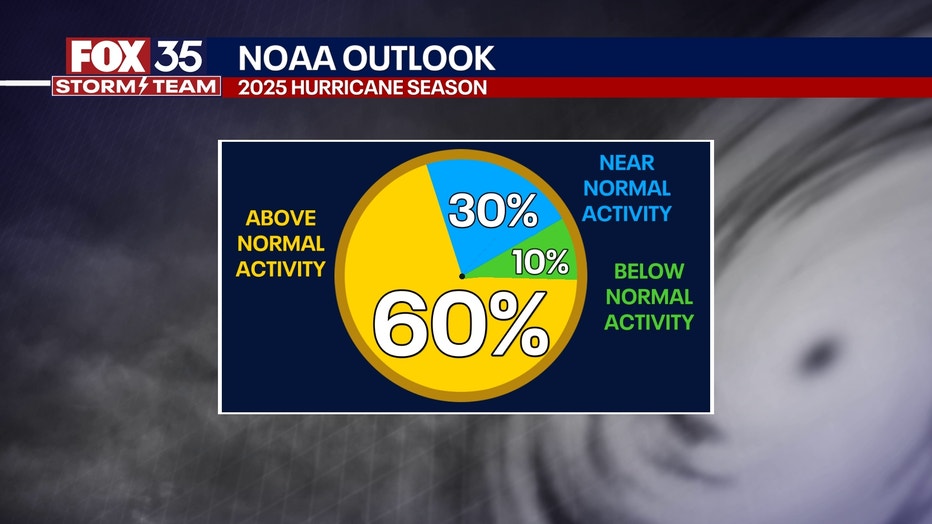
Colorado State University:
- 17 named storms
- 9 hurricanes
- 4 major hurricanes
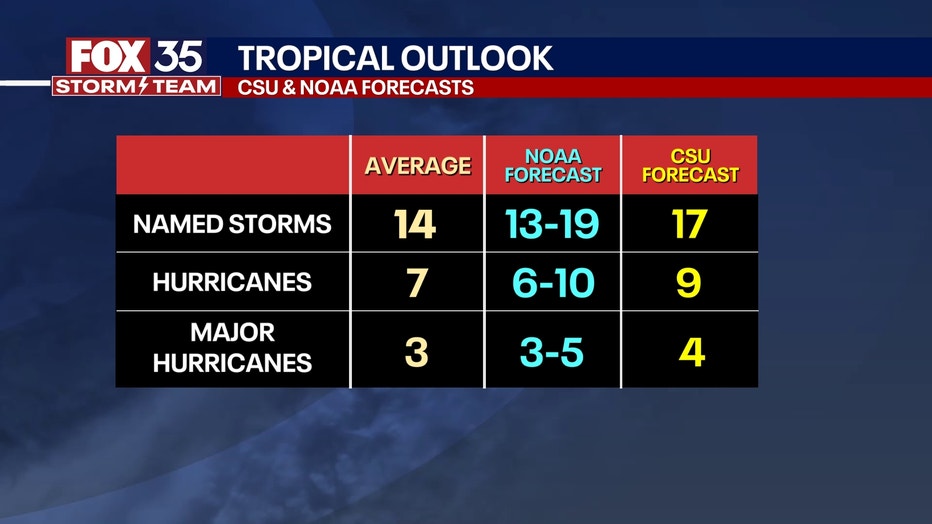
2025 Tropical Outlook
More info: NOAA 2025 Atlantic hurricane season forecast
How do the 2025 predictions compare to the 2024 season?
The 2024 Atlantic hurricane season concluded with:
- 18 named storms
- 11 hurricanes
- 6 major hurricanes
Including three hurricanes that made landfall in Florida.
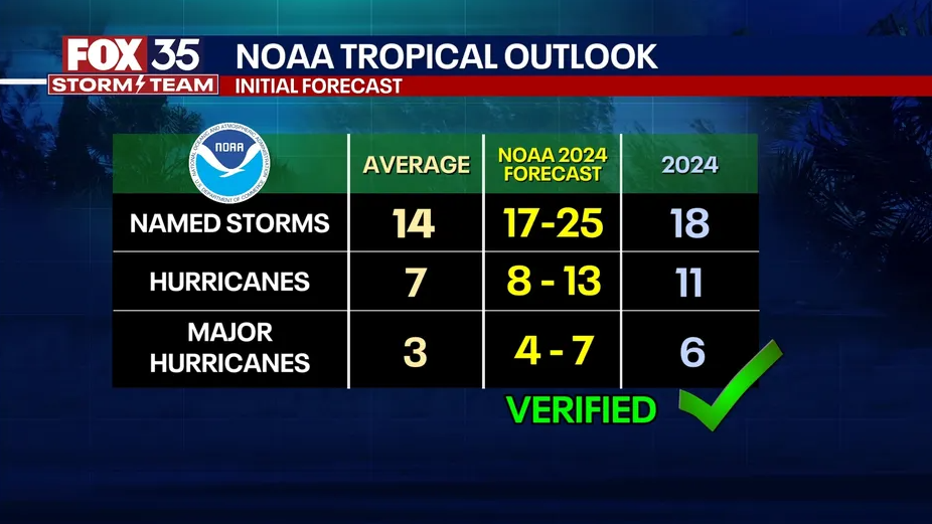
2024 Atlantic Hurricane Season predictions and actual count
NOAA's initial forecast for 2024 predicted:
- 17-25 named storms
- 8-13 hurricanes
- 4-7 major hurricanes
A strong La Niña, which caused cooler Pacific Ocean waters, contributed to reduced wind shear in the Atlantic and fueled a more active season.
For 2025, NOAA forecasts a near-neutral phase at the season's start, with average Pacific Ocean temperatures and near-normal conditions in the Atlantic.
What they're saying:
"In my 30 years at the National Weather Service, we’ve never had more advanced models and warning systems in place to monitor the weather," said NOAA’s National Weather Service Director Ken Graham. "This outlook is a call to action: be prepared. Take proactive steps now to make a plan and gather supplies to ensure you're ready before a storm threatens."
How do I prepare for the Atlantic hurricane season?
Meteorologists predict an active hurricane season, so it is crucial to stay prepared.
When a storm is approaching, there are a few steps you can take to ensure safety and preparedness.
- 7 days away: Stay close and monitor the forecast
- 5 days away: Consider chances of a tropical event
- 4 days away: Top off hurricane supplies
- 3 days away: Personal preparations
- 24 hours away: Finish preparations
- 6 hours away: Hunker down
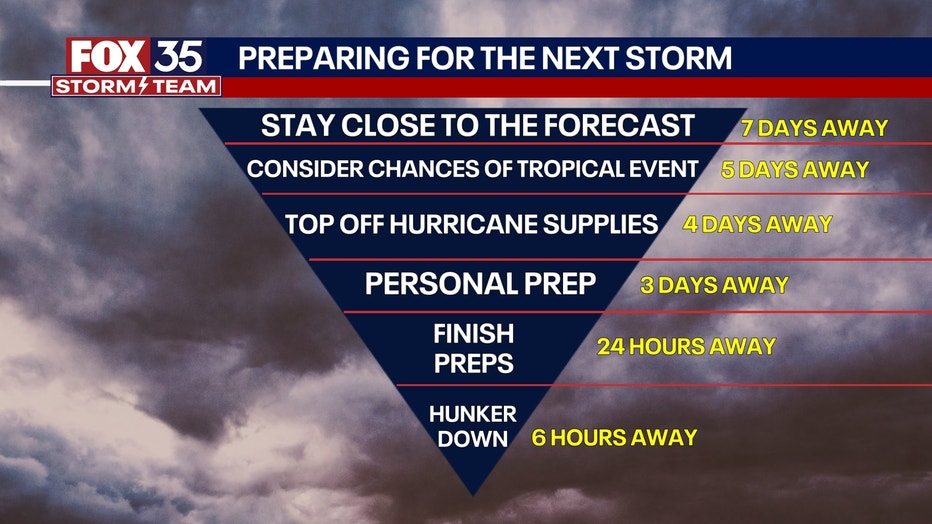
Having a basic disaster supply kit, additional supplies, knowing the Florida evacuation zones and emergency resources you can contact for help is key to staying safe this season.
What should be in a basic disaster supplies kit?
To assemble your kit, store items in airtight plastic bags and put your entire disaster supplies kit in one or two easy-to-carry containers, such as plastic bins or a duffel bag.
A basic emergency supply kit could include the following recommended items:
- Water (one gallon per person per day for at least three days, for drinking and sanitation)
- Food (at least a three-day supply of non-perishable food)
- Battery-powered or hand-crank radio and an NOAA Weather Radio with tone alert
- Flashlight
- First aid kit
- Extra batteries
- Whistle (to signal for help)
- Dust mask (to help filter contaminated air)
- Plastic sheeting and duct tape (to shelter in place)
- Moist towelettes, garbage bags, and plastic ties (for personal sanitation)
- Wrench or pliers (to turn off utilities)
- Manual can opener (for food)
- Local maps
- Cell phone with chargers and a backup battery
FloridaDisaster.org also has an emergency checklist, which has been embedded below.
Additional emergency supplies
Consider adding the following items to your emergency supply kit based on your individual needs:
- Cloth face coverings (for everyone ages 2 and above), soap, hand sanitizer, disinfecting wipes to disinfect surfaces
- Prescription medications
- Non-prescription medications such as pain relievers, anti-diarrhea medication, antacids, or laxatives
- Prescription eyeglasses and contact lens solution
- Infant formula, bottles, diapers, wipes, and diaper rash cream
- Pet food and extra water for your pet
- Cash or traveler's checks
- Important family documents such as copies of insurance policies, identification, and bank account records saved electronically or in a waterproof, portable container
- Sleeping bag or warm blanket for each person
- Complete change of clothing appropriate for your climate and sturdy shoes
- Fire extinguisher
- Matches in a waterproof container
- Feminine supplies and personal hygiene items
- Mess kits, paper cups, plates, paper towels, and plastic utensils
- Paper and pencil
- Books, games, puzzles, or other activities for children
What is my Florida evacuation zone?
If you live in a low-lying area that's prone to flooding, in a mobile home, or an unsafe structure, those areas may be ordered to evacuate during a hurricane, either part of a voluntary evacuation or a mandatory evacuation.
Here is how to find out if you live in an evacuation zone, and what your zone is:
- Visit https://www.floridadisaster.org/knowyourzone/ and click the "Know Your Zone" link.
- Type in your address and see if it is located within a colored evacuation zone (these are flood zones)
- Zone A is typically the most vulnerable, though there are 21 different zone designations among various counties in Florida
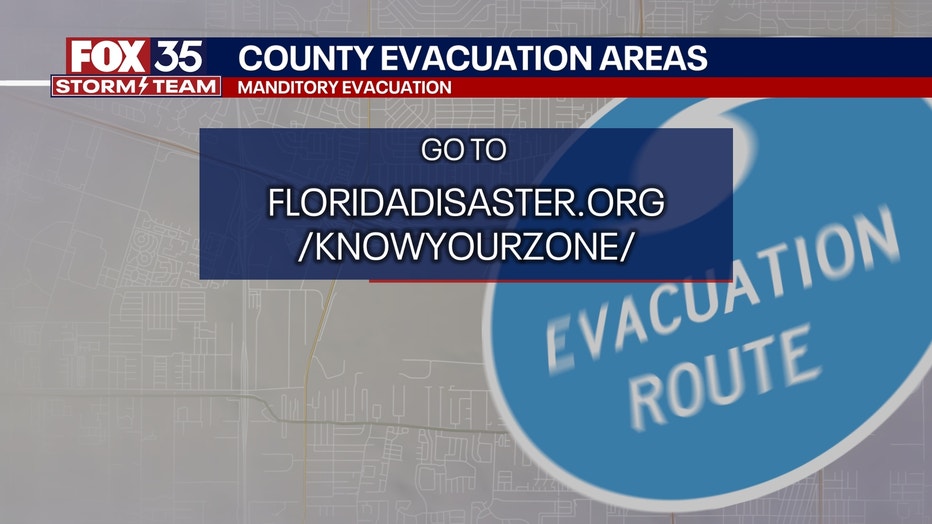
How do I contact Central Florida Emergency Management?
If you're looking for information on closures, emergency shelters, and sandbags, here are links to county emergency management websites:
- Brevard County
- Flagler County
- Lake County
- Orange County
- Osceola County
- Polk County
- Seminole County
- Sumter County
- Volusia County
How many systems are there in an average hurricane season?
- 14 named storms
- 9 hurricanes
- 4 major hurricanes
What are the common terms used during hurricane season?
What is a Tropical Wave?
A wave is a westward-moving atmospheric disturbance that typically forms over warm ocean waters. These systems often serve as the early stages of tropical cyclones, with many tropical storms and hurricanes originating from them.
What is a Tropical Depression?
A tropical depression is a type of tropical cyclone featuring maximum sustained winds of 38 mph (33 knots) or less. It consists of a well-organized cluster of thunderstorms with a clearly defined center of circulation.
What is a Tropical Storm?
A tropical storm is a tropical cyclone with maximum sustained winds between 39 and 73 mph (34 to 63 knots). At this point, the system becomes more organized and is officially named by the National Hurricane Center.
What is a Hurricane?
A hurricane is a powerful tropical cyclone with maximum sustained winds of 74 mph (64 knots) or more. These storms are known for producing strong winds, heavy rainfall, and dangerous storm surge. In the western Pacific, they are referred to as typhoons.
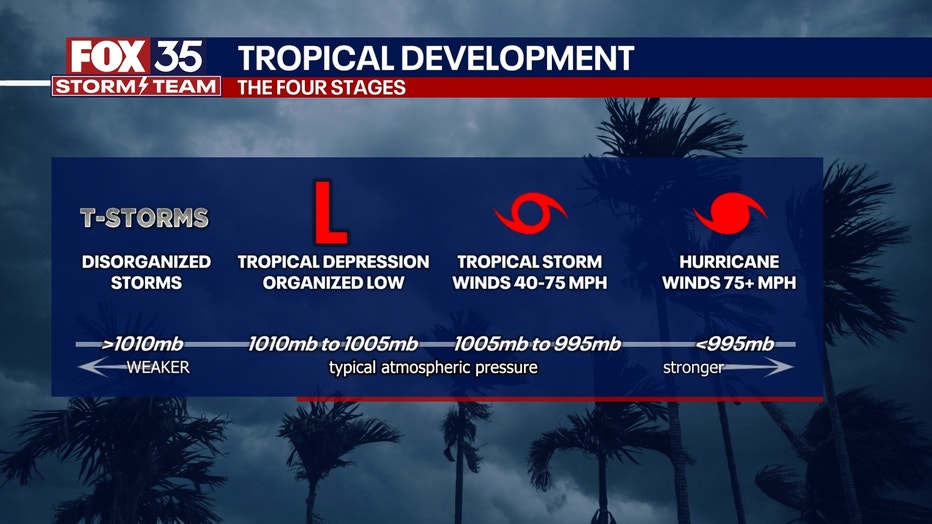
FOX 35 Storm Tracker Radar and Live Weather Cameras
Track live when storms move across your area using the FOX 35 Storm Tracker Radar below. You can also watch as heavy rain moves across Central Florida on our Live Weather Cameras' page here.
More radar maps from FOX 35 Storm Tracker Radar
- Brevard County
- Flagler County
- Marion County
- Osceola County
- Orange County
- Polk County
- Seminole County
- Sumter County
- Volusia County
- U.S./National Radar
STAY CONNECTED WITH FOX 35 ORLANDO:
- Download the FOX Local app for breaking news alerts, the latest news headlines
- Download the FOX 35 Storm Team Weather app for weather alerts & radar
- Sign up for FOX 35's daily newsletter for the latest morning headlines
- FOX Local: Stream FOX 35 newscasts, FOX 35 News+, Central Florida Eats on your smart TV
The Source: This story was written based on information shared by NOAA. NOAA released its 2025 Atlantic hurricane season on May 22, 2025. Colorado State University released its hurricane forecast in April 2025.

